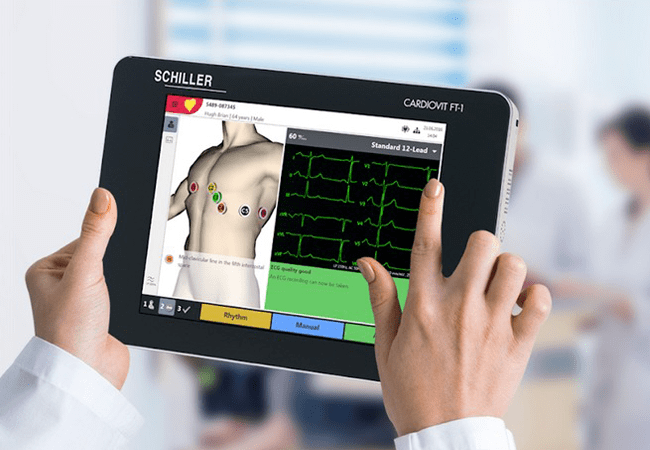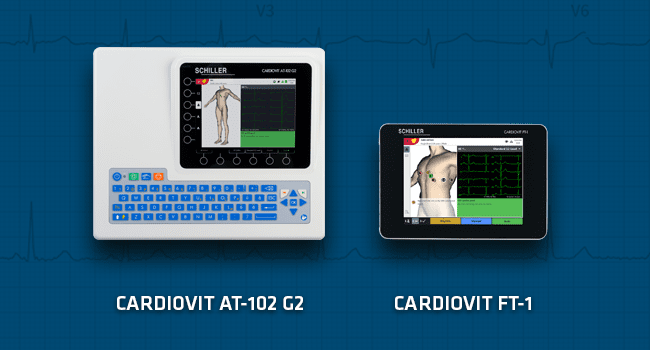

Currently, technological advancements are occurring at a rapid pace, leading to medical devices becoming obsolete in a short period of time. Therefore, it is essential to provide healthcare professionals with state-of-the-art equipment that streamlines patient evaluation and serves as efficient tools for therapeutic decision-making in various clinical scenarios.
The electrocardiogram (ECG) remains the most commonly performed cardiovascular diagnostic test. It is essential in the timely identification and treatment of acute coronary syndromes and is the most accurate in detecting blockages and arrhythmias. Moreover, it allows for the recognition of electrolyte imbalances and serves as a screening tool for individuals without heart disease undergoing non-cardiac surgery or high-performance athletes.
The extensive versatility of the electrocardiogram underscores the importance of accurate recording and interpretation. The use of outdated technology in obtaining ECG tracings can lead to generating more uncertainty than solutions. Its main disadvantage lies in its lack of precision, increasing the workload for healthcare professionals who are compelled to repeat tests to verify results or seek colleagues' opinions, all to compensate for equipment limitations.
To avoid these complications and ensure a more accurate diagnosis, it is essential to have modern EKGs that offer greater measurement precision, enabling a more reliable interpretation and reducing the need for test repetition. Furthermore, it is ideal that they have a user-friendly interface and advanced features that streamline healthcare professionals' tasks, expedite decision-making, and enhance patient care.
In this article, we will explore the numerous advantages of having an ECG that incorporates the latest scientific and technological advancements.
The Dangers of Resisting the New
The Dangers of Resisting the New
As mentioned earlier, EKGs play a crucial role in diagnosing, monitoring, and treating patients with heart conditions. Since their invention 120 years ago, by Willem Einthoven, a Dutch physician and physiologist, ECGs have undergone significant evolution, transforming from simple string galvanometers to sophisticated, state-of-the-art computerized machines.
Despite having a scientific statement from the AHA/ACC/HRS that standardizes the technology ECGs should possess1, the use of modern equipment is not widespread due to various reasons. Many of these are related to budget limitations, but there is also resistance to change and to the adoption of new technologies in the medical field.
While it's true that older equipment can fulfill their function in the short term, technological lag carries serious economic and time-related consequences. However, the most concerning aspect is that it poses potential risks to patients.
Numerous articles outline the drawbacks of incorrect or misinterpreted testing. To name a few:
Incorrect placement of electrodes resulting in erroneous diagnoses. A study conducted by Javier García-Niebla in 2009 underscores the importance of identifying and addressing technical errors in obtaining an electrocardiogram, especially in electrode placement. Additionally, it highlights the negative consequences of inappropriate filter application, which can lead to artifacts being misinterpreted as arrhythmias2.
Inaccurate diagnostic algorithms. In a research by Maya E. Guglin and Deepak Thatai, common errors in the automated interpretation of ECGs are highlighted, emphasizing the limitations of computer systems in this process. The text points out the significance of human validation in the final interpretation and clinical decision-making, along with recommendations to enhance diagnostic accuracy by combining automated interpretation with medical expertise.3
These articles date back more than a decade and focus on failures inherent in the equipment of that era. Using an EKG like that in 2023 means that testing will be carried out at the quality that the devices could provide back then. In today's world, where medicine increasingly relies on technology to be more precise and provide quality care, it is essential to have up-to-date equipment to take advantage of the advances available.
Advantages of ECGs with advanced technology
Advantages of ECGs with advanced technology
In addition, several studies, such as the one conducted by A.P. Shah and S.A. Rubin, highlighted the technological limitations of that time.5 Those deficiencies have been solved today. In fact, many of these functionalities are now standard on electrocardiographs from leading brands such as
Compliance with international regulations: EKGS now meet standards set by international institutions, such as the American Heart Association (AHA) and the European Society of Cardiology (ESC).
Multi-channel visualization: Ideally, 12 or more to get a complete and detailed view of the heart's electrical activity.
Pacemaker detection: Modern EKGs can effectively identify and filter artifacts and detect the presence of pacemakers or other implanted medical devices.
Signal quality check: These devices have a signal quality check function.
High sampling rate and wide bandwidth: This allows reliable traces to be obtained in both pediatric and adult patients, using the same device.
Versatility in the types of tests: These devices allow electrocardiograms at rest and rhythm tracing, all in a single equipment, without problems of lack of memory to store the test data.
Automatic interpretation: Modern EKGs automatically analyze the trace and generate preliminary reports that can help clinicians in decision-making by integrating them with clinical information.
Additional advantages of modern electrocardiographs
Additional advantages of modern electrocardiographs

In addition to the afore mentioned features, which are indispensable for an accurate electrocardiographic recording, there are some other advantages of having an ECG with the most advanced technology, such as:
Touch screen and intuitive graphical interface: Most modern electrocardiographs feature touch screens and an intuitive graphical interface that simplifies setup, operation, and result review.
Anatomical guidance and electrode verification: Some models feature an anatomical guidance system that shows where to place the electrodes on the patient, and also offer an electrode verification function. This eliminates the need for repeat tests and optimizes the doctor's time, as he or she can be confident that the electrodes have been placed correctly.
Portability and compact design: EKG models, like the CARDIOVIT FT-1, allow healthcare professionals to perform exams at different locations, such as hospitals, offices or home care.
Connectivity: Such as USB, Bluetooth or Wi-Fi ports, which allow patient data to be transferred and stored quickly and securely.
Data storage and retrieval: Ability to store and retrieve data from previous tests, making it easy to track patient evolution over time and compare results.
Compatibility with medical information systems: That means EKGs can be integrated with medical information systems and electronic patient records (HIS, EMR) allowing for more efficient and accurate data management. SCHILLER´s CARDIOVIT FT-1 and the AT-102 G2 are good examples of this.
Medical science advances every day, why use tool that are no longer functional nor reliable?
SOURCES
1.KligfieldP,GettesLS,BaileyJJ,etal.Recommendationsforthestandardizationandinterpretationoftheelectrocardiogram:partI:Theelectrocardiogramanditstechnology:ascientificstatementfromtheAmericanHeartAssociationElectrocardiographyandArrhythmiasCommittee,CouncilonClinicalCardiology;theAmericanCollegeofCardiologyFoundation;andtheHeartRhythmSociety:endorsed by the International Society forComputerized Electrocardiology. Circulation.2007;115(10):1306-1324.doi:10.1161/CIRCULATIONAHA.106.180200
2.García-Niebla J, Llontop-García P, Valle-Racero JI, Serra-Autonell G, Batchvarov VN, de Luna AB. Technical mistakes duringthe acquisitionof theelectrocardiogram. ANoninvasiveElectrocardiol. 2009;14(4):389-403.a.doi:10.1111/j.1542-474X.2009.00328
3.GuglinME,ThataiD.Commonerrorsincomputerelectrocardiogram interpretation.IntJCardiol.2006;106(2):232-237.doi:10.1016/j.ijcard.2005.02.007
4.Brailer DJ, Kroch E, Pauly MV. The impact of computer-assisted test interpretationon physician decision making: the case of electrocardiograms. Med Decis Making.1997;17(1):80-86.doi:10.1177/0272989X9701700109
5.Shah AP, Rubin SA. Errors in the computerized electrocardiogram interpretation ofcardiac rhythm. J Electrocardiol. 2007;40(5):385-390. doi:10.1016/j.jelectrocard.2007.03.008
6.https://www.dicardiology.com/article/advances-ecg-technology


